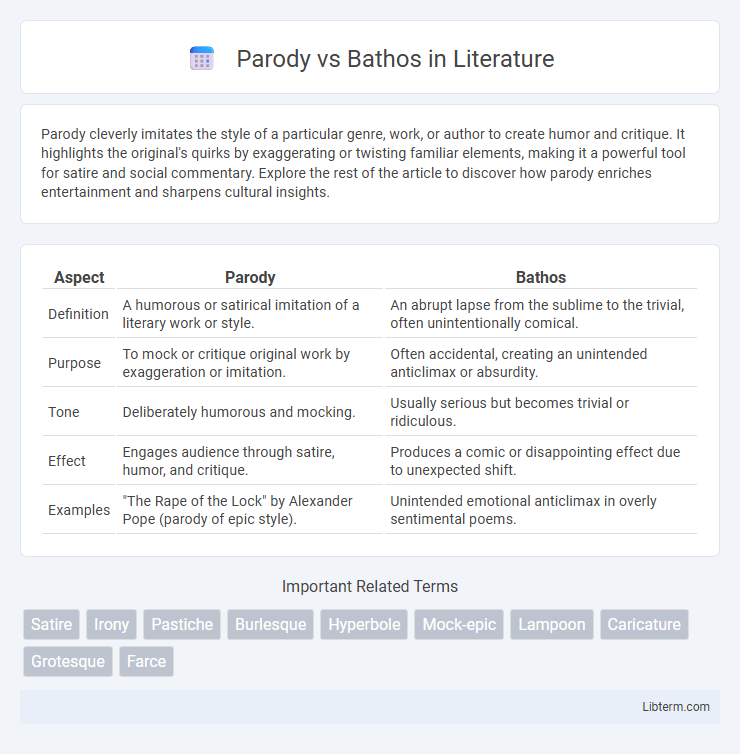Parody cleverly imitates the style of a particular genre, work, or author to create humor and critique. It highlights the original's quirks by exaggerating or twisting familiar elements, making it a powerful tool for satire and social commentary. Explore the rest of the article to discover how parody enriches entertainment and sharpens cultural insights.
Table of Comparison
| Aspect | Parody | Bathos |
|---|---|---|
| Definition | A humorous or satirical imitation of a literary work or style. | An abrupt lapse from the sublime to the trivial, often unintentionally comical. |
| Purpose | To mock or critique original work by exaggeration or imitation. | Often accidental, creating an unintended anticlimax or absurdity. |
| Tone | Deliberately humorous and mocking. | Usually serious but becomes trivial or ridiculous. |
| Effect | Engages audience through satire, humor, and critique. | Produces a comic or disappointing effect due to unexpected shift. |
| Examples | "The Rape of the Lock" by Alexander Pope (parody of epic style). | Unintended emotional anticlimax in overly sentimental poems. |
Understanding Parody and Bathos
Parody is a form of satire that imitates the style or content of another work to create humor or critique, often exaggerating key elements to highlight absurdities. Bathos occurs when a piece of writing or speech shifts abruptly from the serious or sublime to the trivial or ridiculous, causing an unintended comical or anticlimactic effect. Understanding parody and bathos involves recognizing intentional humor through imitation versus accidental tonal shifts that undermine emotional impact.
Defining Parody: Key Characteristics
Parody is a literary or artistic technique that imitates the style or content of another work to create humor or criticism through exaggeration and irony. Key characteristics include mimicry of the original's tone and form, an exaggerated or distorted presentation to highlight its features, and often a satirical intent aimed at the source material or broader cultural themes. Unlike bathos, which produces an abrupt shift from the serious to the trivial causing anticlimax, parody maintains a purposeful connection to the original work's framework for comedic or critical effect.
What is Bathos? Essential Features
Bathos is a literary device that creates an abrupt shift from the serious or sublime to the trivial or ridiculous, often producing an unintended comedic effect. Essential features of bathos include an unexpected descent in tone, exaggerated emotion, and incongruity between the subject matter and its presentation. This technique contrasts sharply with parody, which intentionally mimics and exaggerates stylistic elements for satirical purposes.
Historical Origins of Parody and Bathos
Parody originated in ancient Greek literature, where it was used to mock or satirize existing works by exaggerating their style or content for comic effect, with early examples found in Aristophanes' plays. Bathos emerged in the 18th century with poet Alexander Pope, who described it as an unintended descent from the sublime to the ridiculous, often used to ridicule overly serious art and literature. While parody relies on imitation and humor to critique, bathos hinges on the contrast between elevated expectations and trivial or ludicrous conclusions.
Purposes and Functions in Literature
Parody serves the purpose of humorously imitating a specific work or genre to critique or entertain by exaggerating stylistic features, often highlighting cultural or artistic conventions. Bathos functions to evoke an anticlimactic effect by abruptly shifting from the grandiose to the trivial, creating a contrast that can produce humor or irony and underscore the absurdity within serious contexts. Both devices manipulate audience expectations to reveal deeper insights about narrative tone, literary style, and thematic content.
Techniques Used in Parody
Parody employs techniques such as exaggeration, imitation, and satire to humorously mimic and critique the style or content of the original work. It often uses irony and playful distortion of characters, themes, and dialogues to highlight absurdities or flaws. By blending recognizable elements with comedic twists, parody creates a layered commentary that entertains while provoking thought about the source material.
How Bathos Creates Unintentional Humor
Bathos creates unintentional humor by suddenly shifting from a serious or elevated tone to something trivial or absurd, disrupting audience expectations and causing amusement. Unlike parody, which deliberately mocks its subject through imitation and exaggeration, bathos results from an inadvertent failure to maintain the intended gravitas. This unexpected descent often highlights the discrepancy between the author's goal and the actual effect, making bathos a source of comedic relief due to its unintended silliness.
Comparing Effects: Parody vs Bathos
Parody mimics a particular style or genre to create humor and critique by exaggerating distinctive features, often fostering amusement and intellectual engagement. Bathos abruptly shifts from a serious tone to the trivial or ridiculous, evoking surprise or anticlimax and highlighting emotional disparity. While parody relies on familiarity and satire to entertain, bathos disrupts expectations to provoke reflection or comedic deflation.
Famous Examples in Literature and Media
Parody exploits humor by imitating the style of famous works such as Jane Austen's "Pride and Prejudice" in Seth Grahame-Smith's "Pride and Prejudice and Zombies," blending classic literature with zombie fiction for comedic effect. Bathos, as seen in Alexander Pope's "The Rape of the Lock," uses sudden shifts from the sublime to the trivial to create an anticlimactic comic contrast, highlighting human folly. In media, parody thrives in films like "Scary Movie," spoofing horror genres, whereas bathos appears in shows like "The Simpsons," where lofty setups are deflated by absurd or mundane punchlines.
Practical Tips for Writers: Using Parody or Avoiding Bathos
Writers aiming to use parody effectively should emphasize clever mimicry and exaggeration of original styles without descending into unintentional humor that undermines credibility. To avoid bathos, maintain an appropriate tone and carefully balance emotional shifts to prevent abrupt anticlimax or sentimentality that can disengage readers. Employing clear intent and thoughtful structure enables parody to entertain while sidestepping the pitfalls of bathos.
Parody Infographic

 libterm.com
libterm.com